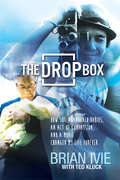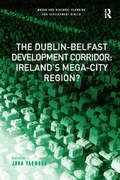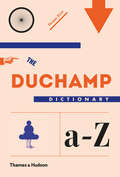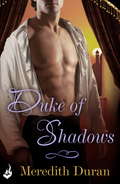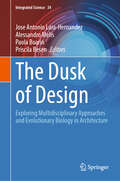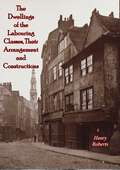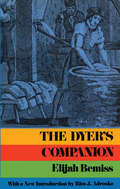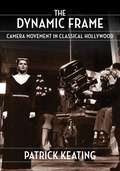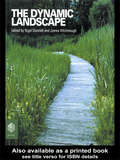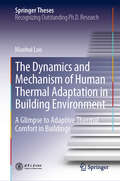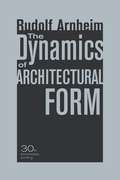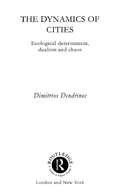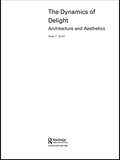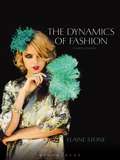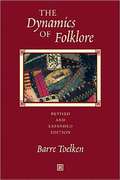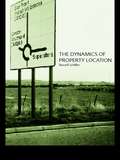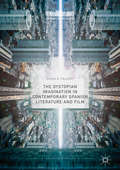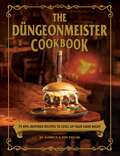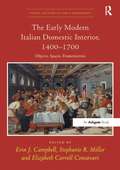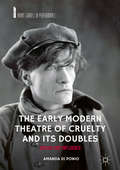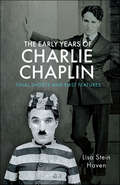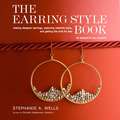- Table View
- List View
The Drop Box
by Ted Kluck Brian IvieBrian Ivie was filled with compassion as he read an LA Times article about Pastor Lee's solution to unwanted newborns in South Korea--a baby drop box. Brian traveled halfway around the world to film the documentary The Drop Box. But God had even bigger plans. For in the midst of filming the plight of these abandoned and forgotten children, Brian realized his own spiritual brokenness. At its heart, this is a story of spiritual orphans--young and old--discovering their true identity as children of God.
The Dublin-Belfast Development Corridor: Ireland’s Mega-City Region? (Urban and Regional Planning and Development Series)
by John YarwoodThe aim of the Dublin-Belfast Development Corridor is to link several towns and cities by various modes of communication in order to create a poly-centric mega-city region in Ireland on a scale large enough to compete with the major urban clusters of continental Europe. This volume brings together an interdisciplinary team of leading scholars and practitioners from both sides of the border to discuss the Dublin-Belfast corridor and the associated challenges of cross-border development from economic, geographic, regional studies, sociological and planning perspectives. As well as providing insight into this important project, the book also throws light on regional development more generally.
The Duchamp Dictionary
by Luke Frost Therese Vandling Thomas Girst"Girst elegantly unravels the skeins of Duchamp's thinking. . . . An essential compendium for puzzling out an essential artist." --Richard Armstrong, Director of the Solomon R. Guggenheim Museum and Foundation Among the most influential artists of the last hundred years, Marcel Duchamp holds great allure for many contemporary artists worldwide and is largely considered to be one of the founding fathers of modern art. Despite this popularity, books on Duchamp are often hyper-theoretical, rarely presenting the artist in an accessible way. This new book explores the artist's life and work through short, alphabetical dictionary entries that introduce his legacy in a clear and engaging way. From alchemy and anatomy to Warhol and windows, The Duchamp Dictionary offers a pithy and readable text that draws on in-depth scholarship and the very latest research. Thomas Girst includes close to 200 entries on the most interesting and important artworks, relationships, people, and ideas in Duchamp's life--from The Bicycle Wheel and Fountain to Walter and Louise Arensberg, Peggy Guggenheim, Katherine Dreier, and Arturo Schwarz. Delightful, newly commissioned illustrations introduce each letter of the alphabet and accompany select entries, capturing the irreverent spirit of the artist himself.
The Duke Of Shadows
by Meredith DuranMeredith Duran returns with another witty, humorous and smart romance. Fans of Julia Quinn, Jane Feather and Eloisa James will delight in Meredith's trademark headstrong heroine, cunning hero and tale of deep emotional intensity!From exotic sandstone palaces... Sick of tragedy, done with rebellion, Emmaline Martin vows to settle quietly into British Indian society. But when the pillars of privilege topple, her fiance's betrayal leaves Emma no choice. She must turn for help to the one man whom she should not trust, but cannot resist: Julian Sinclair, the dangerous and dazzling heir to the Duke of Auburn. To the marble halls of London... In London, they toast Sinclair with champagne. In India, they call him a traitor. Cynical and impatient with both worlds, Julian has never imagined that the place he might belong is in the embrace of a woman with a reluctant laugh and haunted eyes. But in a time of terrible darkness, he and Emma will discover that love itself can be perilous - and that a single decision can alter one's life forever. Destiny follows wherever you run. A lifetime of grief later, in a cold London spring, Emma and Julian must finally confront the truth: no matter how hard one tries to deny it, some pasts cannot be disowned...and some passions never die.Looking for more Meredith Duran novels? Try Written On Your Skin or her Rules for the Reckless series.
The Duke of Wellington, Kidnapped!: The Incredible True Story of the Art Heist That Shocked a Nation
by Noah Charney Alan HirschIn 1961, a thief broke into the National Gallery in London and committed the most sensational art heist in British history. He stole the museum's much prized painting, The Duke of Wellington by Francisco Goya. Despite unprecedented international attention and an unflagging investigation, the case was not solved for four years, and even then, only because the culprit came forward voluntarily. Kempton Bunton, an elderly gentleman, claimed he executed the theft armed with only a toy gun, a disguise purchased for five shillings, and a getaway car inadvertently provided by a drunkard. Shortly after turning himself in, Bunton also invoked language in an obscure law to maintain his innocence, despite the confession. He did not allege that the confession was false, but rather that stealing the painting did not constitute a crime because he intended to return it. On account of this improbable defense strategy, the story took another twist, resulting in a bizarre courtroom drama and extraordinary verdict.Over fifty years later, Alan Hirsch decided to explore the facts behind this historic case and uncovered shocking new evidence that both solved the crime and deepened the mystery. As Hirsch immersed himself in court documents, National Gallery archives, press accounts,
The Dusk of Design: Exploring Multidisciplinary Approaches and Evolutionary Biology in Architecture (Integrated Science #34)
by Alessandro Melis Jose Antonio Lara-Hernandez Paola Boarin Priscila BesenThe Dusk of Design explores the intersection of evolutionary theories and architectural design. Drawing inspiration from the concept of exaptation in biology, the book argues that natural selection, as the most successful designer on our planet, thrives on the diversity, variability, and redundancy of creative structures. By transferring these mechanisms to architectural design, the book contends that we can cultivate more resilient and sustainable architecture and cities in the face of environmental crises.This book seeks to illuminate the profound potential of multidisciplinarity by examining case studies from architecture worldwide. By exploring how evolutionary theories can explain various architectural phenomena, it aims to inspire architects, designers, researchers, and students to adopt a holistic and transdisciplinary approach to their work.The book provides a clear and concise overview of evolutionary principles, demonstrating their relevance to architecture.It will showcase a range of case studies that highlight the application of evolutionary theories in solving architectural challenges, such as adaptive reuse, sustainable urban planning, and resilient design in the face of climate change.Ultimately, "The Dusk of Design" aims to bridge the gap between biology and architecture, presenting a fresh perspective on how we can create more innovative, sustainable, and resilient built environments.
The Dwellings of the Labouring Classes, Their Arrangement and Constructions
by Henry RobertsThe Dwellings of the Labouring Classes: Their Arrangement and Construction by Henry Roberts is a pioneering work on social housing design, published in the mid-19th century during a time of rapid urbanization and industrial growth. Roberts, an influential British architect, addresses the urgent need for better living conditions for the working poor, offering practical solutions to alleviate overcrowding, poor sanitation, and substandard housing. His ideas laid the foundation for modern public housing and urban planning reforms.The book examines the structural and environmental issues plaguing laborers' dwellings in industrial cities, proposing innovative architectural designs aimed at improving both physical health and social well-being. Roberts advocates for the construction of affordable, well-ventilated homes, emphasizing proper lighting, sanitation, and access to green spaces. He includes detailed plans and diagrams for various types of housing, from single-family cottages to multi-unit dwellings, designed to maximize efficiency, comfort, and hygiene within limited urban space.Beyond technical recommendations, Roberts’s work reflects broader social concerns, addressing the relationship between housing, morality, and public health. He argues that well-designed living spaces can foster a sense of dignity and responsibility among the working class, helping to mitigate social unrest and improving public order. His vision aligns with the emerging philanthropic movement of the Victorian era, which sought to balance industrial progress with social responsibility.The Dwellings of the Labouring Classes remains a significant contribution to architecture, urban studies, and social reform. It offers valuable insights into the origins of affordable housing policies and urban planning principles still relevant today. For architects, historians, and social reformers, Roberts's work provides both a historical perspective and inspiration for addressing modern housing challenges.
The Dyer's Companion
by Elijah BemissIn 1806, when Bemiss's Dyer's Companion first appeared, the American dyeing industry was beset with problems; Europe was trying to maintain control of the market, and American dyers were often undertrained with recipes selling from master to apprentice "for twenty and thirty dollars each." To remedy this situation, Elijah Bemiss wrote his book. Today Bemiss's work is still important for seeing the exact methods of natural dyeing and understanding the life of the dyer in the early nineteenth century.This is the complete reprinting of the 1815, greatly expanded, edition. In it the reader can find dye recipes for all shades and varieties of reds, blues, yellows, browns, and blacks divided into dyes for woolens and dyes for linens and cottons, with examples of dyes for both hot and cold dye processes. The early sections give some 119 detailed recipes, the outcome of Bemiss's study and experimentation, and nearly all the dyes the home dyer could want to use. In the second part, the appendix added to the 1815 edition, Bemiss gives more information on setting up vats, on equipment and tools, on the reasons why certain dye materials and methods were chosen, on European methods, and on the differences between the greater and the lesser dyes. A final section gives recipes for inks, dyes for feathers, miracle cures, recipes for beer and mead and other curiosities in the early dyer's repertoire. A new introduction has been written for this Dover edition by Rita J. Adrosko, Curator of the Division of Textiles at the Smithsonian Institution and author of Natural Dyes and Home Drying.Those who have wanted to use natural dyes will find that after they have learned the essentials, they can use this book to extend their list of useful dyes and colors. The book will also be of interest to all who want to know more about early American craft traditions. It allows you to see the materials, the equipment, and the way of life of one of the most important craftsmen in the early years of the American republic.
The Dynamic Frame: Camera Movement in Classical Hollywood (Film and Culture Series)
by Patrick KeatingThe camera’s movement in a film may seem straightforward or merely technical. Yet skillfully deployed pans, tilts, dollies, cranes, and zooms can express the emotions of a character, convey attitude and irony, or even challenge an ideological stance. In The Dynamic Frame, Patrick Keating offers an innovative history of the aesthetics of the camera that examines how camera movement shaped the classical Hollywood style.In careful readings of dozens of films, including Sunrise, The Grapes of Wrath, Rear Window, Sunset Boulevard, and Touch of Evil, Keating explores how major figures such as F. W. Murnau, Orson Welles, and Alfred Hitchcock used camera movement to enrich their stories and deepen their themes. Balancing close analysis with a broader poetics of camera movement, Keating uses archival research to chronicle the technological breakthroughs and the changing division of labor that allowed for new possibilities, as well as the shifting political and cultural contexts that inspired filmmakers to use technology in new ways. An original history of film techniques and aesthetics, The Dynamic Frame shows that the classical Hollywood camera moves not to imitate the actions of an omniscient observer but rather to produce the interplay of concealment and revelation that is an essential part of the exchange between film and viewer.
The Dynamic Landscape: Design, Ecology and Management of Naturalistic Urban Planting
by James Hitchmough Nigel DunnettThe last quarter of the twentieth century witnessed a burgeoning of interest in ecological or naturally-inspired use of vegetation in the designed landscape. More recently, a strong aesthetic element has been added to what was formerly a movement aimed at creating nature-like landscapes. This book advances an innovative fusion of scientific and ecological planting design philosophies which can address the need for more sustainable designed landscapes. It is a major statement on the design, implementation and management of ecologically-inspired landscape vegetation. With contributions from experts at the forefront of development in this area across Europe and North America, this work gives the reader a valuable synthesis of current thinking.
The Dynamics and Mechanism of Human Thermal Adaptation in Building Environment: A Glimpse to Adaptive Thermal Comfort in Buildings (Springer Theses)
by Maohui LuoThis book focuses on human adaptive thermal comfort in the building environment and the balance between reducing building air conditioning energy and improving occupants’ thermal comfort. It examines the mechanism of human thermal adaptation using a newly developed adaptive heat balance model, and presents pioneering findings based on an on online survey, real building investigation, climate chamber experiments, and theoretical models. The book investigates three critical issues related to human thermal adaptation: (i) the dynamics of human thermal adaptation in the building environment; (ii) the basic rules and effects of human physiological acclimatization and psychological adaptation; and (iii) a new, adaptive, heat balance model describing behavioral adjustment, physiological acclimatization, psychological adaptation, and physical improvement effects. Providing the basis for establishing a more reasonable adaptive thermal comfort model, the book is a valuable reference resource for anyone interested in future building thermal environment evaluation criteria.
The Dynamics of Architectural Form (30th Anniversary Edition)
by Rudolf ArnheimThe Dynamics of Architectural Form explores the unexpected perceptual consequences of architecture with Arnheim's customary clarity and precision.
The Dynamics of Cities: Ecological Determinism, Dualism and Chaos
by Dimitrios DendrinosDimitrios Dendrinos, an expert in the application of non-linear dynamics and chaos theory to the subject of urban and regional dynamics, focuses here on fundamental issues in population growth and decline. He approaches the topic of urban growth and decline within a global system perspective, viewing the rise and fall of cities, industries and nations as the result of global interdependencies which lead to unstable dynamics and widespread dualisms. Professor Dendrinos provides valuable insights into the evolution of human settlements and considers the possible futures open to the giant cities of the world.
The Dynamics of Delight: Architecture and Aesthetics
by Peter F. SmithRounding off decades of exploration into the various ways in which buildings and urban sequences make an impact on the mind, The Dynamics of Delight emphasizes the qualitative aspects of form and space, providing designers with an analytical framework in which to evaluate projects on an aesthetic level. In laying the foundations for an appreciation of the aesthetic component in architecture, Smith considers the mechanisms which are involved in the aesthetic response and goes on to consider how human perception may be influenced by natural phenomena and draws on chaos theory and biomathematics to illustrate this original argument.
The Dynamics of Fashion
by Elaine StoneFashion today is fast- paced, technologically savvy, and global-and this fourth edition of The Dynamics of Fashion has been updated to be on the cutting edge. Featuring the latest facts and figures, and the most current theories in fashion development, production, and merchandising, this book provides a broad foundation for students hoping to become a part of the industry. Apparel, accessories, cosmetics, home fashions, green design, and more are explored in detail. Hundreds of examples make the business aspect fun. Fresh, forward, challenging, and comprehensive, Elaine Stone's classic text is for those in fashion who want to be both in the now and in the know.
The Dynamics of Folklore
by Barre ToelkenOne of the most comprehensive and widely praised introductions to folklore ever written. Toelken's discussion of the history and meaning of folklore is delivered in straightforward language, easily understood definitions, and a wealth of insightful and entertaining examples. Toelken emphasises dynamism and variety in the vast array of folk expressions he examines, from "the biology of folklore," to occupational and ethnic lore, food ways, holidays, personal experience narratives, ballads, myths, proverbs, jokes, crafts, and others. Chapters are followed by bibliographical essays, and over 100 photographs illustrate the text. This new edition is accessible to all levels of folklore study and an essential text for classroom instruction.
The Dynamics of Inheritance on the Shakespearean Stage
by Michelle M. DowdEarly modern England's system of patrilineal inheritance, in which the eldest son inherited his father's estate and title, was one of the most significant forces affecting social order in the period. Demonstrating that early modern theatre played a unique and vital role in shaping how inheritance was understood, Michelle M. Dowd explores some of the common contingencies that troubled this system: marriage and remarriage, misbehaving male heirs, and families with only daughters. Shakespearean drama helped question and reimagine inheritance practices, making room for new formulations of gendered authority, family structure, and wealth transfer. Through close readings of canonical and non-canonical plays by Shakespeare, Webster, Jonson, and others, Dowd pays particular attention to the significance of space in early modern inheritance and the historical relationship between dramatic form and the patrilineal economy. Her book will interest researchers and students of early modern drama, Shakespeare, gender studies, and socio-economic history.
The Dynamics of Property Location: Value and the Factors which Drive the Location of Shops, Offices and Other Land Uses
by Russell SchillerWhy is property located where it is and how has this process changed in recent years? A number of factors such as social change and technological development, have affected location and these are considered. Value, the way changing patterns are measured, is examined and there is a discussion of rent contours. The book considers location in the retail industry, looking at the theory, hierarchy, clustering and dispersal. The move to out of town sites, with its three waves of decentralisation, is described. Central place theory, dating from the 1930s, is discounted as being obsolete and misleading. Finally the book covers offices, industrial and residential property.
The Dystopian Imagination in Contemporary Spanish Literature and Film (Hispanic Urban Studies)
by Diana Q. PalardyThis study examines contemporary Spanish dystopian literature and films (in)directly related to the 2008 financial crisis from an urban cultural studies perspective. It explores culturally-charged landscapes that effectively convey the zeitgeist and reveal deep-rooted anxieties about issues such as globalization, consumerism, immigration, speculation, precarity, and political resistance (particularly by Indignados [Indignant Ones] from the 15-M Movement). The book loosely traces the trajectory of the crisis, with the first part looking at texts that underscore some of the behaviors that indirectly contributed to the crisis, and the remaining chapters focusing on works that directly examine the crisis and its aftermath. This close reading of texts and films by Ray Loriga, Elia Barceló, Ion de Sosa, José Ardillo, David Llorente, Eduardo Vaquerizo, and Ricardo Menéndez Salmón offers insights into the creative ways that these authors and directors use spatial constructions to capture the dystopian imagination.
The Düngeonmeister Cookbook: 75 RPG-Inspired Recipes to Level Up Your Game Night (The Ultimate RPG Guide Series)
by Jon Taylor Jef AldrichEat delicious snacks and game-friendly meals in between dice rolls and encounters with this easy-to-follow RPG themed cookbook perfect for every game group.Feed your gamer group with this collection of 75 game-friendly bar bites, finger foods, and easy-to-share meals. With recipes from the passable Goodberries Baked Cheese-wrapped dates to the one-handed Dragon on a Stick Easy-Eat Meat Skewers to the player-favorite Inspiration Points Peanut Butter White Chocolate Pretzels, this cookbook has you covered for any game night adventure. Complete with easy-to-follow recipes and the wit and wisdom of the authors of A Dragon Walks into a Bar and Düngeonmeister, this book will hit the spot for hungry fighters, spellcasters, and anyone else at the table. Additional recipes include: -Goblintzes—Cheese Blintzes -Genasi&’s Delight—Masala Peanuts -Remarkably Movable Rods—Candied Bacon -The Picked Pocket—Hamburger Stuffed Rolls -Healing Words—Lavender Cupcakes with Honey Frosting -Shards of Elemental Chaos—Candy Bark -Hex Grid Cookies—Map-Based Sugar Cookies
The Eagle and the Sun: Agents of Independence Series
by Dana JamesDuring her trip to Mexico, jewellery designer Cass Elliot was to visit the Ibarra opal mines to see the origin of the lovely stones she used and gain inspiration for future designs. She’s unable to prevent Derek Prentice accompanying her, and as her boss’s son he’s not easy to deflect. It doesn’t help to discover that Miguel Ibarra is not expecting them. Just when Cass feels she’s begun to make a better impression on Miguel, Derek becomes difficult and Cass is introduced to Miguel’s fiancée. She no longer knows what to think – will Mexico be the summit of her dreams, or the loss of all hope?
The Early Modern Italian Domestic Interior, 1400–1700: Objects, Spaces, Domesticities (Visual Culture in Early Modernity)
by Erin J. Campbell Stephanie R. Miller Elizabeth Carroll ConsavariEmphasizing on the one hand the reconstruction of the material culture of specific residences, and on the other, the way in which particular domestic objects reflect, shape, and mediate family values and relationships within the home, this volume offers a distinct contribution to research on the early modern Italian domestic interior. Though the essays mainly take an art historical approach, the book is interdisciplinary in that it considers the social implications of domestic objects for family members of different genders, age, and rank, as well as for visitors to the home. By adopting a broad chronological framework that encompasses both Renaissance and Baroque Italy, and by expanding the regional scope beyond Florence and Venice to include domestic interiors from less studied centers such as Urbino, Ferrara, and Bologna, this collection offers genuinely new perspectives on the home in early modern Italy.
The Early Modern Theatre of Cruelty and its Doubles: Artaud and Influence (Avant-Gardes in Performance)
by Amanda Di PonioThis book examines the influence of the early modern period on Antonin Artaud’s seminal work The Theatre and Its Double, arguing that Elizabethan and Jacobean drama and their early modern context are an integral part of the Theatre of Cruelty and essential to its very understanding. The chapters draw links between the early modern theatrical obsession with plague and regeneration, and how it is mirrored in Artaud’s concept of cruelty in the theatre. As a discussion of the influence of Shakespeare and his contemporaries on Artaud, and the reciprocal influence of Artaud on contemporary interpretations of early modern drama, this book is an original addition to both the fields of early modern theatre studies and modern drama.
The Early Years of Charlie Chaplin: Final Shorts and First Features
by Lisa Stein HavenA thorough look into the early life and career of Charlie Chaplin. Charlie Chaplin’s career has been described, critiqued, and scrutinized. There are book-length studies on Chaplin’s music hall career, his career at Keystone Studios and the Mutual Studios. Somehow, his tenure with First National studios, however, has been largely neglected, even though it was during this several-year contractual time period that Chaplin built and occupied his own studio for the first time, that he attempted and succeeded in filming a comedy feature (The Kid) and that he helped to set up United Artists, an organization that protected the salaries and creative freedom of actors in Hollywood. This period in Chaplin’s story is especially interesting because such landmark moments are accompanied by Chaplin’s first marriage and divorce, the death of his first child, his friendship with French silent film comedian Max Linder, World War I and the role he would play in it, and the production and release of several unsuccessful films that marked Chaplin’s first creative blockage - one that threatened his future career. This book will discuss the transitional periods just before and after the First National contract, as well as the all-important period satisfying it. Archival evidence provides most of the support for the book’s assertions, from the Chaplin archive (property of Roy Export, digitized by Cineteca di Bologna, Italy), and the personal archives of other individuals or institutions discussed. Rare photos will illustrate the story.
The Earring Style Book
by Stephanie A. WellsCreate an entire earring wardrobe--no stylist required Stephanie Wells's unique, trendsetting Double Happiness earrings have been regularly spotted on Oprah, Alicia Keys, Rachael Ray, and Beyoncé. Here, the award-winning designer shows you how to make 40 of her signature earring styles--without sacrificing time or budget. You'll learn basic jewelry making skills, as well as Double Happiness techniques for making frames, wrapping wires and beads, and connecting multiple wraps. Whether your style is chic, glamorous, rock-and-roll, or bohemian, you'll find easy-to-make earrings that will revive--and revolutionize--any outfit.From the Trade Paperback edition.
